What's cuing salmon migration patterns?

The spring-fed water that flows through Hansen Creek in southwestern Alaska is almost always clear. Its rate and temperature stay relatively constant throughout the year. Each summer, sockeye salmon migrate through the shallow, narrow creek bed in distinct pulses, in a migration pattern common to salmon populations around the world.
Why the salmon move in pulses is the subject of a new paper published today in Animal Behavior.
"The folk wisdom is that the salmon are all independently cueing off common environmental cues, and that tends to synchronize their movements," says co-author Andrew Berdahl, an SFI Omidyar Fellow. That trigger could be a change in tide or water temperature or the patterns of the moon.
But in Hansen Creek, where researchers have recorded the movement of salmon for the past 20 years, salmon arrive in pulses despite the very stable environmental conditions. Furthermore, existing models, which invoke environmental cues, don't predict migration pulses very well. In the new paper, Berdahl and colleagues suggest that social cues might be the key to understanding the group migrations.
"Because you see this pulsed movement in places where standard explanations say you shouldn't, it leaves us searching for another mechanism," says Berdahl. "Maybe they're cueing off each other."
To test the theory, the group developed a model where individual fish could independently decide to migrate. But if one fish left, it increased the probability that another would leave also. This small chance that one fish might copy another can create a cascade—a pulse in the migration. This simple model reproduces the patterns of migration timing observed in the real fish at Hansen Creek.
Group migration is a matter of survival. It helps a larger percentage of the population make it past hungry predators waiting on the banks, and is likely important for salmon to successfully navigate home. Understanding the cues that trigger migration—both environmental and social—could be important for wildlife management.
"Climate change is altering both the optimal timing of migrations and the cues used to stimulate those migrations," says Berdahl. "If you want to know how migratory animals are going to respond to this change, you have to pay attention to social interactions—which is what we think determines the fine-scale movement decisions—or you're going to miss an important part of the picture."
More information: Andrew Berdahl et al. Social interactions shape the timing of spawning migrations in an anadromous fish, Animal Behaviour (2017). DOI: 10.1016/j.anbehav.2017.01.020
Journal information: Animal Behavior , Animal Behaviour
Provided by Santa Fe Institute


















